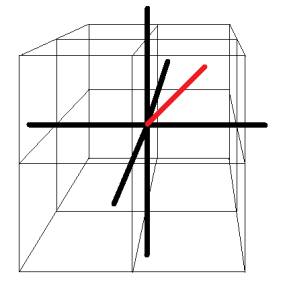
A vector in a three-dimensional space.
I envision the emotional or spiritual world as a ten-dimensional space, in which a vector (arrow) beginning at the origin (the center of the space) depicts a person’s emotional state at any point in time. The vector’s length indicates the intensity of one’s emotions at a given moment, while its direction indicates what kinds of feelings those are — equal parts joy and sadness, for example, or some anger and much love.
These are the energies one is emanating at that moment, the kinds of light or darkness one creates.
(Darkness in the spiritual world is not like darkness in the material world. In the material world, darkness is merely the absence of light. In the spiritual world, darkness is substantial. It is the presence of negative energies or feelings.)
Some regions of the space are lighter than others. I could not get the correct shading into the figure, but normally when that figure is used, positive values — and so, we may suppose, light — increase in one direction as one moves from left to right, and in another direction as one moves from front to back, and in a third direction as one moves from the bottom up. But my model uses ten dimensions.
Given free will, each of us is completely free to change the vector’s length or direction however one may choose. Completely free. One meets no resistance in moving in any direction. No cosmic “STOP” sign or practical difficulty appears to warn one against straying into dark regions.
Normally, most people spend most of their time in the brighter regions. Doing so presents many practical advantages, even evolutionary (Darwinian) ones. It is on the basis of most folk acting this way most of the time, that humanity has achieved what it has.
(Related, as to the evolutionary advantages of altruism:
Rat empathy— previous post here
If It Feels Good to Be Good, It Might Be Only Natural — Washington Post article
Human fronto–mesolimbic networks guide decisions about charitable donation — the original research described in the Post article.)
Each of us does wander into darkness from time to time. Even Jesus lost his temper. A small portion of the population, however, practically live there.
From “The dark side of EQ:”
Paul Bloom and others conducted an important experiment at Yale; the following quotation is from Katie R. Billings’ report, Is Altruism Innate?
“In the first experiment, infants between the ages of six and ten months watched a series of puppet shows. Each puppet had a unique shape and color for the infants to easily distinguish. The first puppet, a red ball, struggled to climb a hill. On several occasions, the red ball was pushed up the hill by a yellow triangle. On other occasions, the red ball was pushed back down the hill, during its struggle, by a blue square. After watching the puppet show at least six times, the infants selected their favorite puppet, either the yellow triangle or the blue square. Over 80 percent of the infants chose the ‘helpful’ puppet, a surprisingly high, statistically significant percentage.”
I am glad that Billings reports how many of the infants acted this way; that detail was left out of previous reports I’ve read. I wonder about the 20%. Could their conduct now suggest a certain karmic predisposition, and perhaps warn of possible problems to come?
The social effects of habitual creation of darkness, even by (normally) a small part of the population, are disastrous.
10% of the people commit 90% of crime.
It affects life expectancies.
On the one hand, given our complete freedom to go wherever we choose in that space, it is inevitable that some folk — again, normally a small percentage — will happen to become fascinated with the dark regions.
Some people love to hate.
All of us are susceptible to become this way.
Look at the current state of political discourse in this country.
On the other hand, if habitual creation of darkness is the principal cause of poverty, then poverty can never be eliminated on any complete or permanent basis.
Evangelism is a matter of coaxing the arrow into the light.
We can evangelize ourselves.
By the path of presence, one can become increasingly aware of one’s ability to choose one’s feelings, and thus able to exercise that choice.
I believe this is what Jesus really taught.
———— ♦ ————
This is the fourth in a series of five posts:
“Just how bad do you think you’ve got it?” – May 10, 2014
The Life Force: Use and abuse – May 17, 2014
Co-creators with God – May 24, 2014
The wandering will – Today
The path of presence – June 7, 2014
(Reblogged 10/18/18.)
Pingbacks:
2014-12-20 – Status report: A snapshot of my life right now
2015-10-03 – What you “see” is what you’ll get
2017-03-11 – Keep the feeling, change the thought
2018-08-06 – Balances
2019-03-09 – The Bogeyman